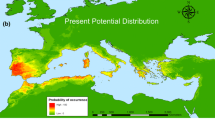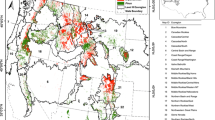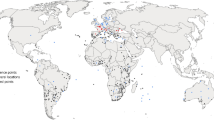Abstract
Global warming enables the immigration of species previously absent from a given region. Coraebus florentinus (Coleoptera: Buprestidae) is a beetle with a Mediterranean distribution that has expanded its northern range margin northwards within the last 30 years. It develops in branches and shoots of oak (Quercus spp.) and is considered a pest in Mediterranean countries. By modelling the current spatial distribution of C. florentinus using three independent modelling approaches (generalised linear models, boosted regression trees, maximum entropy modelling) we identified abiotic factors which explain its current spatial distribution (1991–1999) in south-west Germany and reconstructed its immigration into Germany since 1950. All modelling approaches suggest that monthly maximum temperatures determined the range margin of the species in south-west Germany from 1991 to 1999. Occurrence probabilities increased exponentially with mean maximum temperatures higher than 10 °C in March and 22 °C in June. Mean precipitation in May also seems to be important for the species occurrence, particularly in regions where oaks grow on poor sandy soil; however, this generally plays a minor role. All of these environmental conditions are linked to higher reproduction of C. florentinus on oaks in warm and dry habitats, as reported from southern Europe. We show that climatic conditions for the beetle have improved significantly in south-west Germany since 1950, which is most likely the reason for the northward shift of its range margin. Our modelling results suggest a further range expansion of the beetle in Central Europe.





Similar content being viewed by others
References
Allen CD, Macalady AK, Chenchouni H, Bachelet D, McDowell N, Vennetier M, Kitzberger T, Rigling A, Breshears DD, Hogg EH, Gonzalez P, Fensham R, Zhang Z, Castro J, Demidova N, Lim JH, Allard G, Running SW, Semerci A, Cobb N (2010) A global overview of drought and heat-induced tree mortality reveals emerging climate change risks for forests. For Ecol Manag 259:660–684
Altmoos M, Henle K (2010) Relevance of multiple spatial scales in habitat models: a case study with amphibians and grasshoppers. Acta Oecol 36:548–560
Augustin NH, Mugglestone MA, Buckland ST (1996) An autologistic model for the spatial distribution of wildlife. J Appl Ecol 33:339–347
Badeck F-W, Pompe S, Kühn I, Glauer A (2008) Wetterextreme und Artenvielfalt. Zeitlich hochauflösende Klimainformationen auf dem Messtischblattraster und für Schutzgebiete in Deutschland. Naturschutz und Landschaftsplanung 40:343–345
Battisti A, Stastny M, Buffo E, Larsson S (2006) A rapid altitudinal range expansion in the pine processionary moth produced by the 2003 climatic anomaly. Glob Chang Biol 12:662–671
Brechtel F, Kostenbader H (2002) Die Pracht- und Hirschkäfer Baden-Württembergs. Ulmer, Stuttgart
Brechtel F, Niehuis M (2010) Der Florentiner Prachtkäfer—Coraebus florentinus (Hbst., 1801)—in Rheinland-Pfalz (Insecta: Coleoptera: Buprestidae). Fauna Flora Rheinland-Pfalz 11:1117–1124
Brechtel F, Ehrmann R, Detzel P (1996) Zum Vorkommen der Gottesanbeterin Mantis religiosa (Linné, 1758) in Deutschland. Carolinea 54:73–90
Bregant E, Fritz JJ, Walluschek-Wallfeld H (1999) Bemerkenswerte Prachtkäferfunde in Österreich (Coleoptera, Buprestidae). Joannea Zoologie 1:65–70
Buse J, Griebeler EM (2011) Incorporating classified dispersal assumptions in predictive distribution models—a case study with grasshoppers and bush-crickets. Ecol Model 222:2130–2141
Climatetemp (2011) http://www.climatetemp.info. Accessed 9 Feb 2011
Clusella-Trullas S, Blackburn TM, Chown SL (2011) Climatic predictors of temperature performance curve parameters in ectotherms imply complex responses to climate change. Am Nat 177:738–751
Curletti G (1994) I Buprestidi d’Italia. Catalogo, Tassonomico, Sinonimico, Biologico, Geonemico. Monographie di Natura Bresciana 19, Brescia
De’ath G (2007) Boosted trees for ecological modeling and prediction. Ecology 88:243–251
De’ath G, Fabricius KE (2000) Classification and regression trees: a powerful yet simple technique for ecological data analysis. Ecology 81:3178–3192
Detzel P (1998) Die Heuschrecken Baden-Württembergs. Ulmer, Stuttgart
Deutsch CA, Tewksbury JJ, Huey RB, Sheldon KS, Ghalambor CK, Haak DC, Martin PR (2008) Impacts of climate warming on terrestrial ectotherms across latitude. Proc Natl Acad Sci USA 105:6668–6672
Dormann CF, McPherson JM, Araújo MB, Bivand R, Bolliger J, Carl G, Davies RG, Hirzel A, Jetz W, Kissling WD, Kühn I, Ohlemuller R, Peres-Neto PR, Reineking B, Schröder B, Schurr FM, Wilson R (2007) Methods to account for spatial autocorrelation in the analysis of species distributional data: a review. Ecography 30:609–628
Drees C, Brandmayr P, Buse J, Dieker P, Gürlich S, Habel J, Harry I, Härdtle W, Matern A, Meyer H, Pizzolotto R, Quante M, Schäfer K, Schuldt A, Taboada A, Assmann T (2011) Poleward range expansion without a southern contraction in the ground beetle Agonum viridicupreum (Coleoptera, Carabidae). In: Kotze DJ, Assmann T, Noordijk J, Turin H, Vermeulen R (eds) Carabid beetles as bioindicators: biogeographical, ecological and environmental studies. ZooKeys 100:333–352
Drobyshev I, Niklasson M, Eggertsson O, Linderson H, Sonesson K (2008) Influence of annual weather on growth of pedunculate oak in southern Sweden. Ann For Sci 65:512. doi:10.1051/forest:2008033
Eichhoff WJ (1878) Aus Mühlhausen im Ober-Elsass. Entomologische Zeitung Stettin 39:197–200
Elith J, Graham CH, Anderson RP, Dudik M, Ferrier S, Guisan A, Hijmans RJ, Huettmann F, Leathwick JR, Lehmann A, Li J, Lohmann LG, Loiselle BA, Manion G, Moritz C, Nakamura M, Nakazawa Y, McC. Overton J, Townsend Peterson A, Phillips SJ, Richardson K, Scachetti-Pereira R, Schapire RE, Soberon J, Williams S, Wisz MS, Zimmermann NE (2006) Novel methods improve prediction of species’ distributions from occurrence data. Ecography 29:129–151
Elith J, Leathwick JR, Hastie T (2008) A working guide to boosted regression trees. J Anim Ecol 77:802–813
Evans HF, Moraal LG, Pajares JA (2004) Biology, ecology and economic importance of Buprestidae and Cerambycidae. In: Lieutier F, Day RK, Battisti A, Gregoire J-C, Evans FH (eds) Bark and wood boring insects in living trees in europe, a synthesis. Kluwer Academic Publishers, Dordrecht, pp 447–474
Fielding AH, Bell JF (1997) A review of methods for the assessment of prediction errors in conservation presence/absence models. Environ Conserv 24:38–49
Geiser R (1998) Rote Liste der Käfer (Coleoptera). Schriftenreihe für Landschaftspflege und Naturschutz 55:194–201
Hanley JA, McNeil BJ (1982) The meaning and use of the area under a receiver operating curve (ROC). Radiology 143:29–36
Harrell FEJ (2001) Regression modelling strategies: with applications to linear models, logistic regression, and survival analysis. Springer, New York
Hellrigl K (2010) Faunistik der Prachtkäfer von Südtirol (Coleoptera: Buprestidae). For Obs 5:153–206
Hickling R, Roy DB, Hill JK, Thomas CD (2005) A northward shift of range margins in British Odonata. Glob Chang Biol 11:502–506
Hill JK, Thomas CD, Huntley B (2001) Climate and recent range changes in butterflies. In: Walther G-R, Burga CA, Edwards PJ (eds) “Fingerprints” of climate change. Adapted behaviour and shifting species ranges. Kluwer Academic, New York, pp 77–88
Hochkirch A, Damerau M (2009) Rapid range expansion of a wing-dimorphic bush-cricket after the 2003 climatic anomaly. Biol J Linn Soc 97:118–127
Hosmer DW, Lemeshow S (2000) Applied logistic regression. Wiley, New York
IPCC (2007) Climate change 2007: the physical science basis. In: Solomon S, Qin D, Manning M, Chen Z, Marquis M, Averyt KB, Tignor M, Miller HL (eds) Contribution of working group I to the fourth assessment report of the intergovernmental panel on climate change. Cambridge University Press, Cambridge
Liu C, Berry PM, Dawson TP, Pearson RG (2005) Selecting thresholds of occurrence in the prediction of species distributions. Ecography 28:385–393
Lombardero MJ, de Ana Fernandez, Magan FJ (1996) Distribucion y danos de Coroebus florentinus (Herbst) (Col., Buprestidae) en Galicia (no de la Peninsula Iberica). Ecologia 10:499–508
Mac Nally R (2000) Regression and model-building in conservation biology, biogeography and ecology: the distinction between—and reconciliation of—‘predictive’ and ‘explanatory’ models. Biodivers Conserv 9:655–671
Moraal LG, Hilszczansky J (2000) The buprestid beetle, Agrilus biguttatus (F.) (Col., Buprestidae), a recent factor in oak decline in Europe. J Pest Sci 5:134–138
Musolin DL (2007) Insects in a warmer world: ecological, physiological and life-history responses of true bugs (Heteroptera) to climate change. Glob Chang Biol 13:1565–1585
Netherer S, Schopf A (2010) Potential effects of climate change on insect herbivores in European forests—general aspects and the pine processionary moth as specific example. For Ecol Manag 259:831–838
Niehuis M (2004) Die Prachtkäfer in Rheinland-Pfalz und im Saarland. GNOR-Eigenverlag, Mainz
Orlowsky B (2006) A statistical model for regional climate scenarios. In: Kundzewicz ZW, Hattermann FF (eds) Natural systems and global change. Research Center for Agricultural and Forest Environment of the Polish Academy of Sciences, Potsdam Institute for Climate Impact Research, Poznan, pp 28–34
Ott J (2010) Dragonflies and climatic change—recent trends in Germany and Europe. BioRisk 5:253–286
Pearce JL, Boyce MS (2006) Modelling distribution and abundance with presence-only data. J Appl Ecol 43:405–412
Phillips SJ, Anderson RP, Schapire RE (2006) Maximum entropy modelling of species geographic distributions. Ecol Model 190:231–259
Quante M (2010) The changing climate: past, present, future. In: Habel JC, Assmann T (eds) Relict species: phylogeography and conservation biology. Springer, Berlin, pp 9–56
Recalde JI, San Martin AF (2003) Coleópteros xilófagos asociados a ramas de Quercus muertas por la acción del bupréstido Coraebus florentinus (Herbst, 1801) en la Navarra media. Heteropterus Revista de Entomologia 3:43–50
Schapire RE, Singer Y (1999) Improved boosting algorithms using confidence-rated predictions. Mach Learn 37:297–336
Schröder B (2006) ROC and AUC-calculation—evaluating the predictive performance of habitat models. Computer program, version 1.3. http://brandenburg.geoecology.uni-potsdam.de/users/schroeder/download.html
Schröder B (2008) Challenges of species distribution modelling belowground. J Plant Nutr Soil Sci 171:325–337
Shannon CE (1948) A mathematical theory of communication. Bell Syst Tech J 27:379–423
Solinas M (1971) Considerazioni ecologiche sul preoccupante sviluppo di Coraebus florentinus (Herbst) nelle leccete del Gargano. Entomologica 7:115–121
Solinas M (1974) Coraebus florentinus (Herbst) (Coleoptera, Buprestidae). Biologia, Danni, lotta Entomologica 10:141–193
von dem Bussche J, Spaar R, Schmid H, Schröder B (2008) Modelling the recent and potential future spatial distribution of the Ring Ouzel (Turdus torquatus) and Blackbird (T. merula) in Switzerland. J Ornithol 149:529–544
Walther G-R, Burga CA, Edwards PJ (2001) “Fingerprints” of climate change. Adapted behaviour and shifting species ranges. Kluwer Academic, New York
Williams DW, Liebhold AM (2002) Climate change and the outbreak ranges of two North American bark beetles. Agric For Entomol 4:87–99
Acknowledgments
This study was funded as part of the project “Klima- und Landschaftswandel in Rheinland-Pfalz (KlimLandRP)” run by the “Ministerium für Umwelt, Forsten und Verbraucherschutz” of Rhineland-Palatinate, Germany. Many thanks go to Franz Badeck for his support with respect to the use of climate data from the TKCLIM-database. Soil data were kindly provided by the “Bundesanstalt für Geowissenschaften und Rohstoffe”. We thank Christophe Bouget, Hervé Brustel, Benjamin Calmont, Gianfranco Curletti, Jakub Horak, Marcos Méndez, and Louis-Michel Nageleisen for providing record data and general information on the spatial distribution of the beetle.
Author information
Authors and Affiliations
Corresponding author
Rights and permissions
About this article
Cite this article
Buse, J., Griebeler, E.M. & Niehuis, M. Rising temperatures explain past immigration of the thermophilic oak-inhabiting beetle Coraebus florentinus (Coleoptera: Buprestidae) in south-west Germany. Biodivers Conserv 22, 1115–1131 (2013). https://doi.org/10.1007/s10531-012-0395-y
Received:
Accepted:
Published:
Issue Date:
DOI: https://doi.org/10.1007/s10531-012-0395-y




